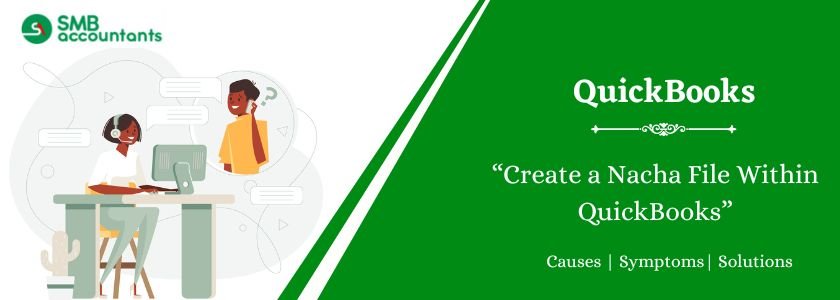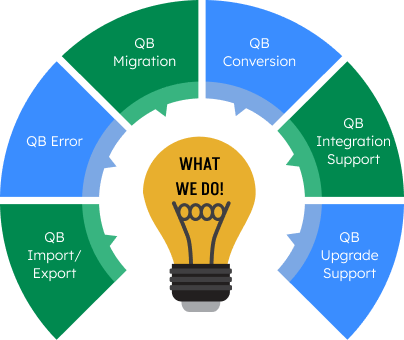Electronic payments within the ACH network operate using standardized files which NACHA (National Automated Clearing House Association) maintains. Businesses simplify the processing of direct deposits and vendor payments while performing electronic fund transactions by using NACHA files. QuickBooks users can generate NACHA files through its system to conduct ACH transactions automatically which reduces manual intervention and eliminates errors. This complete guide teaches you how to build NACHA (National Automated Clearing House Association) files within QuickBooks by showing all steps from understanding file organization to making adjustments and future industrial developments.
Table of Contents
- 1 Understanding the Structure of a NACHA File
- 2 Gathering Necessary Information for NACHA File Creation
- 3 How to Create a NACHA File Using QuickBooks (or Excel)
- 4 Future of NACHA Formatted ACH Files
- 5 How to Edit a NACHA File?
- 6 Conclusion
- 7 Frequently Asked Questions
- 7.1 Q 1: QuickBooks NACHA files enable the processing of which types of financial transactions?
- 7.2 Q 2: Which QuickBooks versions enable users to create NACHA files?
- 7.3 Q 3: For NACHA file uploads, which bank requirements must I meet?
- 7.4 Q 4: What is an ACH Origination Agreement?
- 7.5 Q 5: How should I proceed when creating or transmitting NACHA files that result in errors?
- 8 Adams Williams
Understanding the Structure of a NACHA File
The National Automated Clearing House Association has established particular rules that govern NACHA file organization. Companies need to comprehend NACHA file structures to develop efficient NACHA file production systems. The NACHA file distributes its data content through specific records that perform distinct operational functions.
- File Header Record (Record Type 1)
Among the first records is the information which specifies both file originator and destination as well as the file creation date and additional control parameters.
- Batch Header Record (Record Type 5)
Each batch commencing cycle begins with record type 5. NACHA files support the addition of various batches within one processing document. The service code, along with the company name, appears in this record along with other batch details (slang PPD for Prearranged Payment and Deposit, CCD for Cash Concentration and Disbursement).
- Entry Detail Record (Record Type 6)
An entry detail record (Record Type 6) includes necessary transaction information about receivers’ bank accounts, payment amounts, and whether the funds will be credited or debited. Every batch contains multiple entries detailed within its records.
- Addenda Record (Record Type 7)
There is supplemental information regarding an entry detail record in this document. The supplementary information is presented in the form of optional records for various types of transactions that require additional supplementary data.
- Batch Control Record (Record Type 8)
The Batch Control Record (Record Type 8) is used to summarize the batch data by indicating entry quantities and financial total amounts. The record is used to ensure data integrity.
- File Control Record (Record Type 9)
The last entry in the file is summary data for the entire document, consisting of batch and entry counts as well as the total transaction dollar amount. The records have individual fields established by definite sizes and data types. NACHA file processing necessitates full compliance with prescribed specifications.
Get Expert Advice to Fix All Accounting & Bookkeeping Problems

Gathering Necessary Information for NACHA File Creation
The creation of NACHA files requires all important data ready for processing.
The proper accuracy and fulfilment of data represent key requirements for ACH transaction execution. The absence of proper information combined with inaccurate entries results in denied transactions while introduction of delays and potential expenses to the process.
Step 1: Company Information
Your company information requires its full legal name beside the address along with Tax Identification Number and bank details which include routing number and account number.
Step 2: Receiver Information
The information needed for each payment recipient includes name and address and bank account data comprising routing number and account number and choosing between checking and savings as their account type.
Step 3: Transaction Details
Every transaction requires listing the payment amount along with a specific date and a clear reference describing the transaction. Together with payment details, you will need the payment schedule when dealing with recurring payments.
Whichever role accepts a debit through your system needs permission from the account holder before you can initiate withdrawals. This authorization should be documented.
Step 5: Service Code
Decide on the correct NACHA service code that fits the transaction type between PPD for direct deposits and CCD for business-to-business payments.
How to Create a NACHA File Using QuickBooks (or Excel)
QuickBooks has capabilities to build certain NACHA files yet complex situations may require external tools in addition to Excel.
Steps using QuickBooks:
Step 1: Set up Vendor/Employee Information
Check that each vendor, together with each worker you pay, maintains precise bank account details within your QuickBooks system.
Step 2: Create Bills/Paychecks
Users should establish their bills and paychecks inside the QuickBooks platform.
Step 3: Select “Direct Deposit” or “ACH” Option
When processing payments, select either direct deposit or ACH as payment options. QuickBooks provides step-by-step assistance for the operation.
Step 4: Generate NACHA File
The NACHA file originates from the payment data recorded in QuickBooks.
Step 5: Review and Transmit
Check the NACHA file for correct information prior to sending the file to your bank.
Steps using Excel (for more complex scenarios):
Step 1: Create a Spreadsheet
You should create a spreadsheet that reproduces the NACHA file format by adding columns that represent all fields found in individual record types.
Step 2: Enter Data
Enter all necessary transaction data which must comply with NACHA specifications.
Step 3: Format Cells
Apply correct data types and format lengths that comply with the NACHA specifications to the cells.
Step 4: Save as Text File
A spreadsheet needs to be converted to a text file (.txt) structure by using the comma-separated or tab-separated format.
Step 5: Convert to NACHA Format
An application that creates NACHA files together with a script may be needed to convert the text file to its proper NACHA format.
You may read this: How to Fix QuickBooks ND File Error
Future of NACHA Formatted ACH Files
The ACH network, along with its NACHA file format, continues to transform itself consistently to fulfill the requirements of contemporary payment systems.
- Faster Payments
Real-time payment technology has gained significant momentum because it changes the usual length of ACH transactions. The payment system provider NACHA works to implement speedier payment choices.
- Increased Security
Expanded protective measures aiming at preventing both data theft and fraudulent activities have been established across systems.
- API Integration
Payment system integration, as well as automatic NACHA file generation and distribution, have become simpler because of API technology.
- Standardization
The NACHA format continues to undergo standardization improvements, which ensure better communication between different payment systems.
- Blockchain Integration
Fundamental payment tracking is enabled through blockchain technology, which provides both security and transparency for users.
You also read this: How to Create a New Company File in QuickBooks
How to Edit a NACHA File?
The adjustment of payment and correction of mistakes is possible through editing NACHA files. Perfect precision is vital for maintaining the structural conformity of NACHA files.
Methods of Editing NACHA Files:
Step 1: Using Text Editors
Specific field modifications should occur through the use of Notepad++ together with equivalent software platforms.
Step 2: QuickBooks Adjustments
Execute the corrections inside QuickBooks then ask the program to regenerate the file.
Step 3: Third-Party NACHA Editing Tools
Specific NACHA file editing software tools are available for use.
Tools for NACHA File Editing
NACHA file editing has multiple efficient tools available for users to employ. Here are some popular options:
Recommended Tools:
1: Notepad++
The tool serves as an efficient solution for performing direct text file modifications.
2: ACH Universal
A NACHA file generator and editor with validation features.
3: QuickBooks ACH Export
Users can make minor adjustments to NACHA files right before the file generation process.
4: Excel Macros
The system utilizes custom scripts which both translate and validate NACHA data format.
5: Bank-Specific NACHA Tools
Certain financial institutions make proprietary editing tools for NACHA available to their customers.
Manually Editing a NACHA File
The process of editing a NACHA file requires great caution because any errors in data and formatting can generate transaction failures. Transaction failures will occur from any errors found in formatting or data.
Step 1: Backup the File
Every NACHA file needs one backup copy before starting any updates.
Step 2: Open the File
Operate the NACHA file through the use of a text editor.
Step 3: Locate the Record
Choose the individual database entry that demands updates.
Step 4: Make Changes
Edit the data inside the record by following both NACHA specifications and field size requirements.
Step 5: Recalculate Control Totals
When editing transaction amounts or entries in your records you need to recalculate all control totals located in batch control and file control sections.
Step 6: Save the File
Save the edited NACHA file.
Step 7: Validate the File
A NACHA file validation tool allows users to detect any errors in the file.
Conclusion
The creation of NACHA files through QuickBooks provides an efficient procedure that advances monetary dealings as well as maintains compliance with banking standards. The creation process for NACHA files either starts from QuickBooks or through Excel, but needs to stay precise at all times. Efficiency can be improved through NACHA file editing expertise alongside specialized tool usage. NACHA file processing is projected to advance into a more secure automated system that will provide advantages to businesses operating throughout different industries.
Frequently Asked Questions
Q 1: QuickBooks NACHA files enable the processing of which types of financial transactions?
Ans: The NACHA file generation in QuickBooks extends to different transaction types such as:
- Payroll: Direct deposit of employee salaries.
- Vendor Payments: Electronic payments to suppliers and vendors.
- Customer Payments: Accounts of customers receive deposits directly through their accounts for invoice payments via the NACHA system.
- Refunds: Electronic refunds to customers.
- Reimbursements: Electronic reimbursement of employee expenses.
Q 2: Which QuickBooks versions enable users to create NACHA files?
Ans: Whether or not you can create a NACHA file is based on the specific version of QuickBooks you are running. There is a capability to create a NACHA file in both QuickBooks Desktop Enterprise and some versions of QuickBooks Online depending on subscription information. Other improvements and system links need to be added to QuickBooks Pro and Premier software to work. They must confirm NACHA file creation capability in their existing QuickBooks version through product features or by contacting Intuit support.
Q 3: For NACHA file uploads, which bank requirements must I meet?
Ans: Banks expect specific parameters for NACHA files, which all their customers must follow.
- File Naming Conventions: Most banks create their own set of requirements when it comes to naming NACHA files.
- File Size Limits: The system restricts NACHA file transmission to particular file size parameters.
- Transmission Methods: Banks typically prefer using secure file transfer protocol (SFTP) as their method for NACHA file transmission.
- Cut-off Times: Finance institutions have set deadlines for NACHA file transfers, which determine whether payments are processed within a day or the following one.
- Prenotification Requirements: Banks require prenotification for specific cases involving initial account debits in transactions.
- ACH Origination Agreement: The bank needs you to sign an origination agreement for ACH to process the payments.
Q 4: What is an ACH Origination Agreement?
Ans: A business can initiate Automated Clearing House transactions through an agreement named ACH Origination Agreement, which it signs with its financial institution. The document establishes all responsibilities that both parties need to fulfil regarding security measures and liability requirements, and transaction limits. Every business must obtain an ACH Origination Agreement to transmit NACHA files with its bank.
Q 5: How should I proceed when creating or transmitting NACHA files that result in errors?
Ans: When you meet errors you should examine a few things.
- Data Accuracy: Check both bank account and routing number data as well as all transaction information for accuracy.
- File Format: The NACHA file needs to follow the precise format requirements of your banking institution.
- Bank Requirements: Check all the requirements your bank specifies regarding file naming and maximum allowable file size and the systems it accepts for data transmission.
- QuickBooks Settings: Double-check your QuickBooks settings for NACHA file creation.
Note: Contact either QuickBooks support or your financial institution to receive help when you cannot solve the problem.

Adams Williams
Adams Williams is a seasoned accounting professional with over 4 years of experience in bookkeeping, financial reporting, and business accounting solutions. Specializing in QuickBooks software, Adams combines technical expertise with clear, accessible content writing to help businesses streamline their financial processes. His insightful guides and how-to articles are crafted to assist both beginners and seasoned users in navigating accounting software with confidence.



